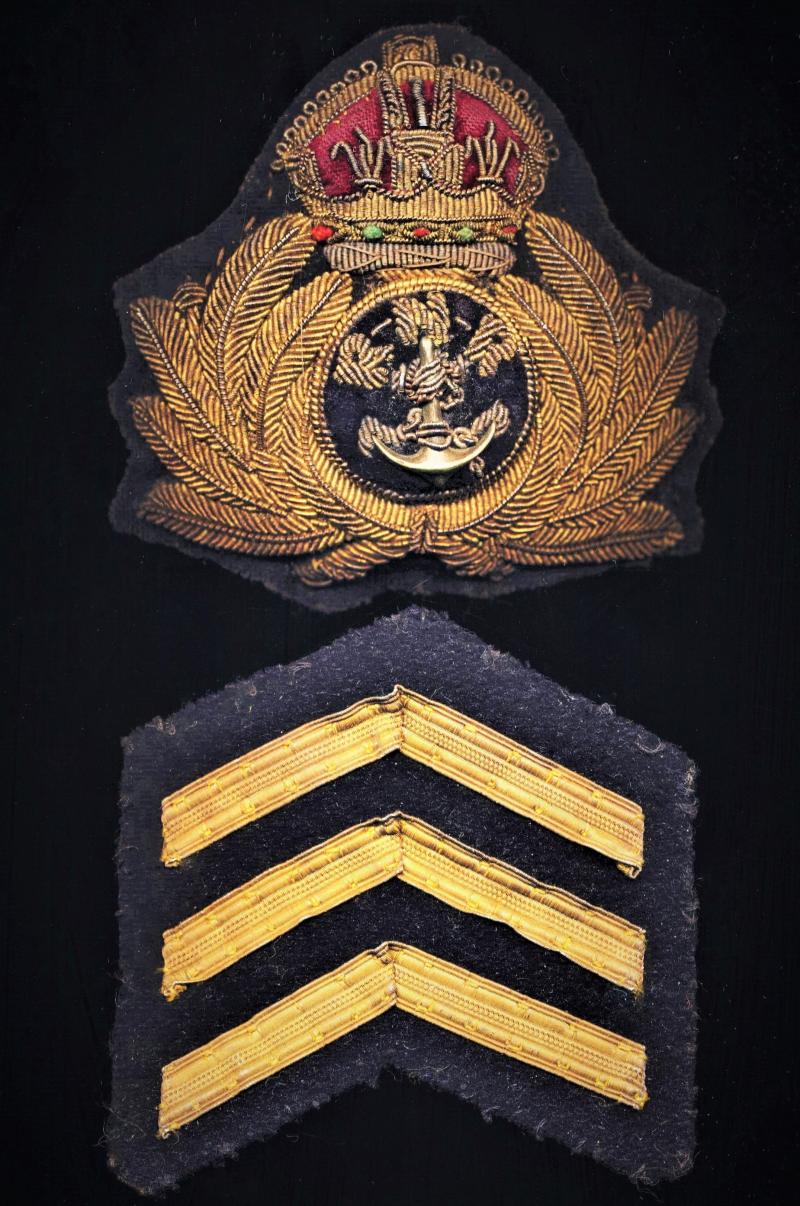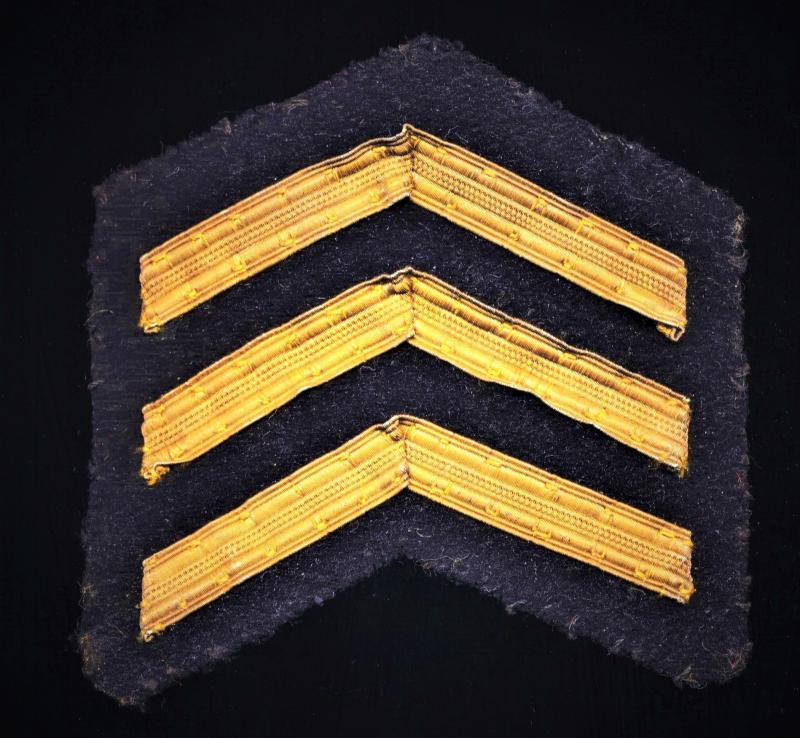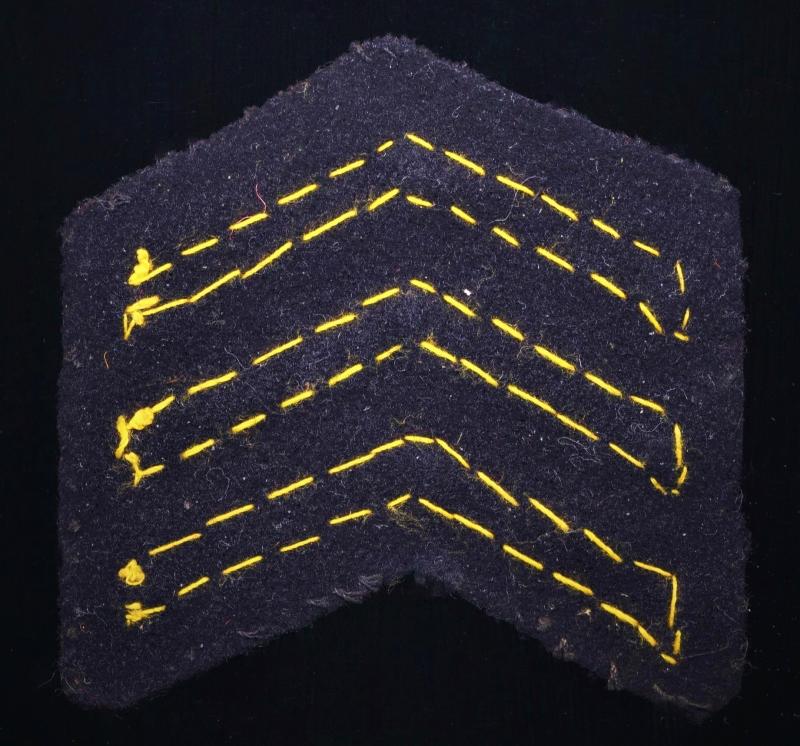Royal Naval Reserve / Royal Navy: Lot of Officer's Cap Badge & Great War Sea Chevrons (1915-1917), positively attributed as worn by Skipper George McIntosh Smith, Royal Naval Reserve
The lot comprises original Great War Royal Naval Reserve insignia that was formerly worn by Skipper Smith, Royal Naval Reserve, whose Great War medals are listed separately for sale on this website
- Royal Naval Reserve: Officer’s bullion cap badge 1901-1920
- Royal Navy (& RN Reserves): Officers 3 X gilt 'Sea Chevrons'
Dimensions of the R.N.R. Officers cap badge are; 73mm wide & 60mm high
Note: Each gilt 'Sea Chevron' denotes one years sea going service in consecutive years; 1915, 1916 & 1917
R.N.R. Officers Cap Badge:The officers cap badge comprising a gold wire embroidered crowned laurel wreath; with central silver fouled anchor with gold wire “R.N.R” above. Backed with black hessian covered with waxed black paper. This being the pattern worn by R.N.R. Officers only between 1901-1920. In 1920, the badge with R.N.R. was subdued, and all Naval Reserve Forces adopted for wear the standard Royal Navy officers badges without any abbreviated letters to denote the force that that they served in
Sea Chevrons: The official notification pertaining to this insignia was published in May 1918:
Quote,
The Secretary of the Admiralty announced the conditions for the award to members of the Royal Navy and the other marine services of chevrons for service at sea and overseas.
They will be awarded to denote services overseas, or at sea undertaken since August 4, 1914, and are to be worn in uniform.
Service overseas and at sea is defined as service at sea in sea-going ships of war, auxiliaries, in defensively armed merchant ships as guns’ crews, and those employed in minesweeping. Officers and men of the late R.N. Air Service who, although serving in the United Kingdom, were liable for service in the air for offensive or defensive purposes, may count such service as qualifying service. Service in kite balloons when embarked in ships will also count.
The date for the award of the first chevron will be August 5, 1914, in the case of those serving at sea or abroad on that date. In other cases the date on which the individual began or begins qualifying service as defined - for example, an individual who began qualifying service on December 31, 1915, is entitled to his first chevron on that date.
Additional chevrons are to be awarded as follows:
(a) From January 1, 1915, to December 31, 1917, inclusive, on a calendar year basis, that is, one chevron and not more than one for each of the years 1915, 1916, and 1917. The individual must have an aggregate of three months' qualifying service in the calendar year to entitle him to the award for that year.
1914 Silver Chevron The chevrons will be ¼ in. in width, the arms 1¼ in. long. They will be worn inverted on the right forearm. Chevrons for officers will be of silver or gold braid. The first chevron, if earned on or before December 31, 1914, will be silver; if earned on or after January 1, 1915, it will be gold, and all additional chevrons after the first will be gold. The silver chevron will be worn below the gold one. For ratings they will be of worsted embroidery of two colours - red and blue. The first chevron, if carried on or before December 31, 1914, will be red; if earned on or after January 1, 1915 it will be blue; and all additional chevrons after the first will be blue.
In the case of officers they are to be worn on the blue undress coat only.
The chevrons are a distinction to be worn on uniform to denote service at sea or overseas since the outbreak of war, and are not to be regarded as being in the nature of a reward. There will, therefore, be no posthumous award to fallen officers or men. The chevrons may be worn in plain clothes by officers and men who have left the Service, but who would, had they remained in the Service, have been entitled to wear them on uniform. In such cases, application for authority to wear the chevrons must be made.
Unquote.
War Badges were stopped being awarded in uniform sometime before the end of 1922. As the Great War campaign medals had mostly been issued by the end of 1922, wound stripes, and sea chevrons for war service were no longer to be worn in uniform.
A scarce lot of R.N.R. Officer's insignia
Condition: VF
Code: 20992







